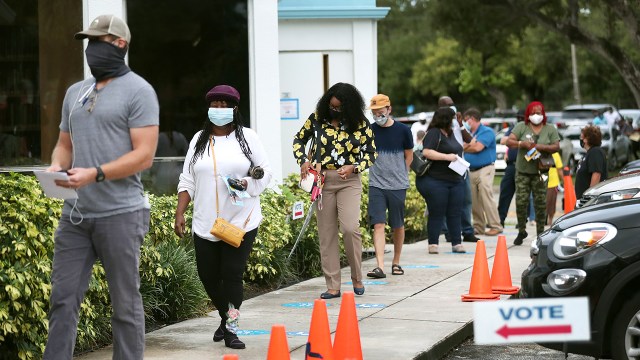
The United States holds a presidential election every four years, but it’s not just the candidates and issues that change from one campaign cycle to the next. The electorate itself is in a slow but constant state of flux, too.
The profile of the U.S. electorate can change for a variety of reasons. Consider the millions of Americans who have turned 18 and can vote for president for the first time this year, the immigrants who have become naturalized citizens and can cast ballots of their own, or the longer-term shifts in the country’s racial and ethnic makeup. These and other factors ensure that no two presidential electorates look exactly the same.
So what does the 2020 electorate look like politically, demographically and religiously as the race between Republican President Donald Trump and Democrat Joe Biden enters its final days? To answer that question, here’s a roundup of recent Pew Research Center findings. Unless otherwise noted, all findings are based on registered voters.
Party identification
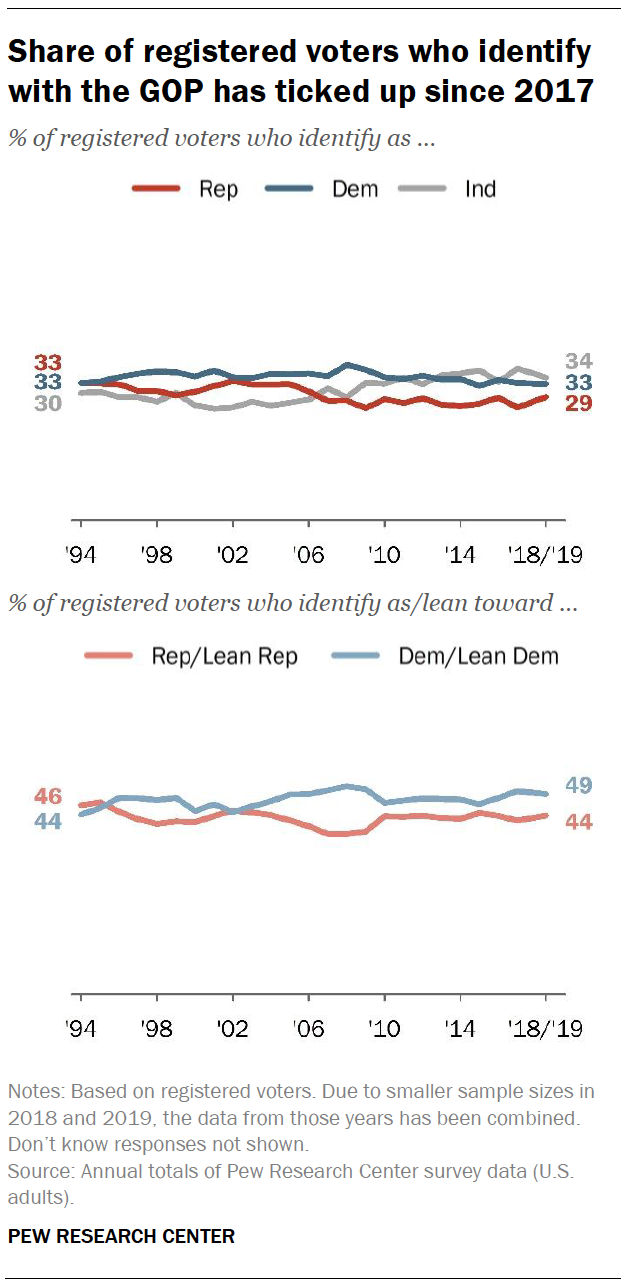
Around a third of registered voters in the U.S. (34%) identify as independents, while 33% identify as Democrats and 29% identify as Republicans, according to a Center analysis of Americans’ partisan identification based on surveys of more than 12,000 registered voters in 2018 and 2019.
Most independents in the U.S. lean toward one of the two major parties. When taking independents’ partisan leanings into account, 49% of all registered voters either identify as Democrats or lean to the party, while 44% identify as Republicans or lean to the GOP.
Party identification among registered voters hasn’t changed dramatically over the past 25 years, but there have been some modest shifts. One such shift is that the Democratic Party’s advantage over the Republican Party in party identification has become smaller since 2017. Of course, just because a registered voter identifies with or leans toward a particular party does not necessarily mean they will vote for a candidate of that party (or vote at all). In a study of validated voters in 2016, 5% of Democrats and Democratic leaners reported voting for Trump, and 4% of Republicans and GOP leaners reported voting for Hillary Clinton.
Race and ethnicity
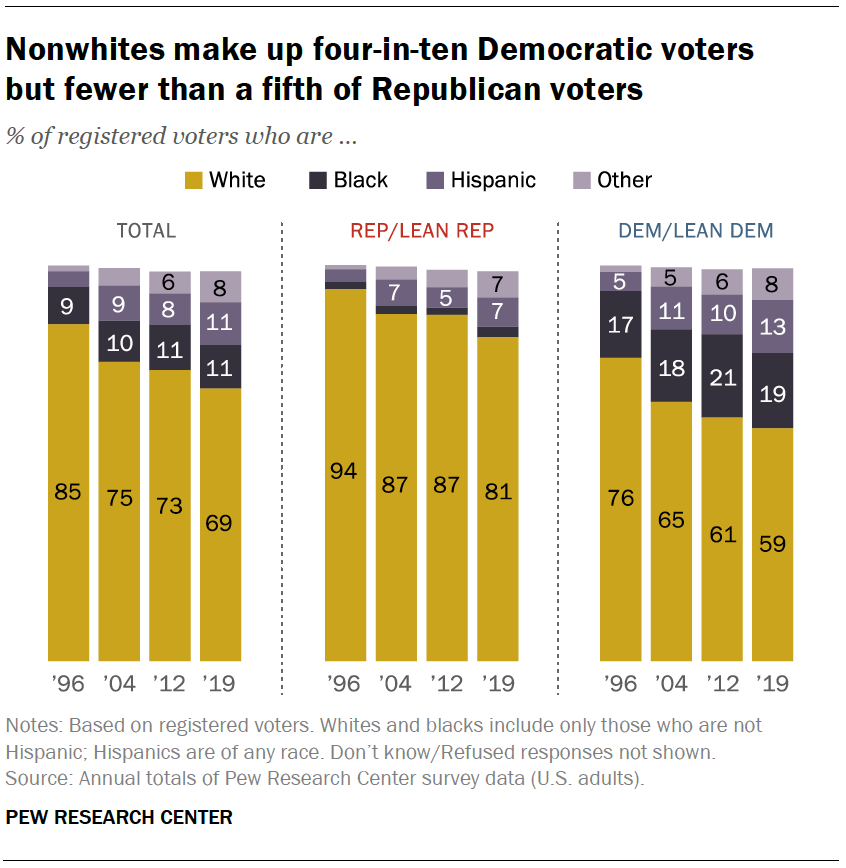
Non-Hispanic White Americans make up the largest share of registered voters in the U.S., at 69% of the total as of 2019. Hispanic and Black registered voters each account for 11% of the total, while those from other racial or ethnic backgrounds account for the remainder (8%).
White voters account for a diminished share of registered voters than in the past, declining from 85% in 1996 to 69% ahead of this year’s election. This change has unfolded in both parties, but White voters have consistently accounted for a much larger share of Republican and Republican-leaning registered voters than of Democratic and Democratic-leaning voters (81% vs. 59% as of 2019).
The racial and ethnic composition of the electorate looks very different nationally than in several key battleground states, according to a Center analysis of 2018 data based on eligible voters – that is, U.S. citizens ages 18 and older, regardless of whether or not they were registered to vote.
White Americans accounted for 67% of eligible voters nationally in 2018, but they represented a much larger share in several key battlegrounds in the Midwest and Mid-Atlantic, including Wisconsin (86%), Ohio (82%), Pennsylvania (81%) and Michigan (79%). The reverse was true in some battleground states in the West and South. For example, the White share of eligible voters was below the national average in Nevada (58%), Florida (61%) and Arizona (63%). You can see racial and ethnic breakdown of eligible voters in all 50 states – and how it changed between 2000 and 2018 – with this interactive feature.
Age and generation
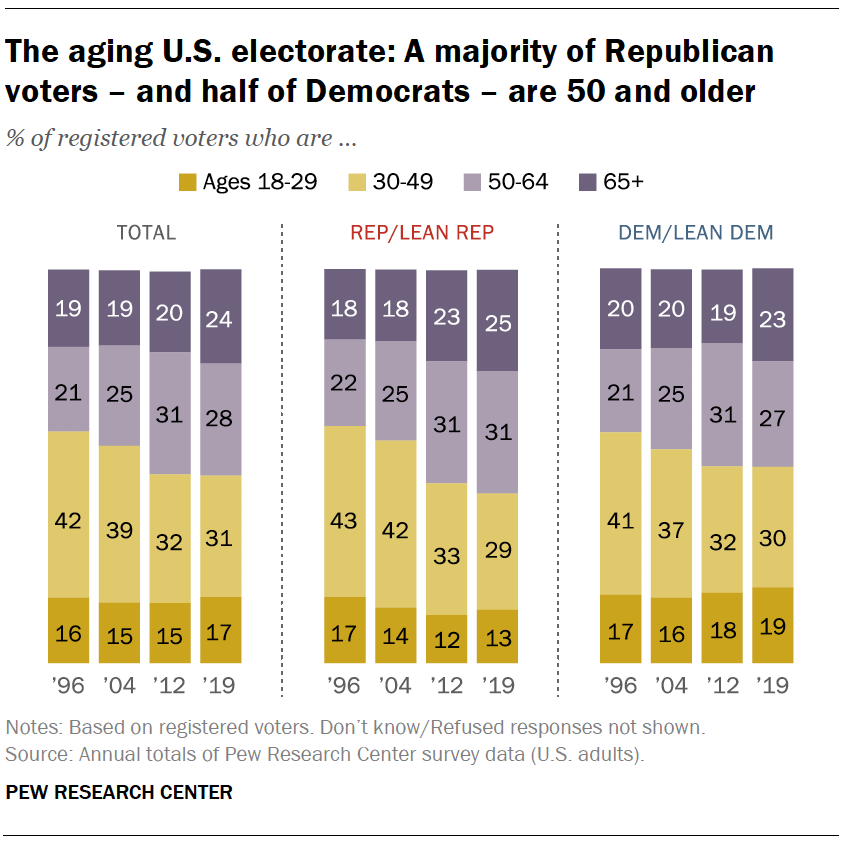
The U.S. electorate is aging: 52% of registered voters are ages 50 and older, up from 41% in 1996. This shift has occurred in both partisan coalitions. More than half of Republican and GOP-leaning voters (56%) are ages 50 and older, up from 39% in 1996. And among Democratic and Democratic-leaning voters, half are 50 and older, up from 41% in 1996.
Another way to consider the aging of the electorate is to look at median age. The median age among all registered voters increased from 44 in 1996 to 50 in 2019. It rose from 43 to 52 among Republican registered voters and from 45 to 49 among Democratic registered voters.
Despite the long-term aging of registered voters, 2020 marks the first time that many members of Generation Z – Americans born after 1996 – will be able to participate in a presidential election. One-in-ten eligible voters this year are members of Generation Z, up from just 4% in 2016, according to Pew Research Center projections. (Of course, not all eligible voters end up registering and actually casting a ballot.)
Education
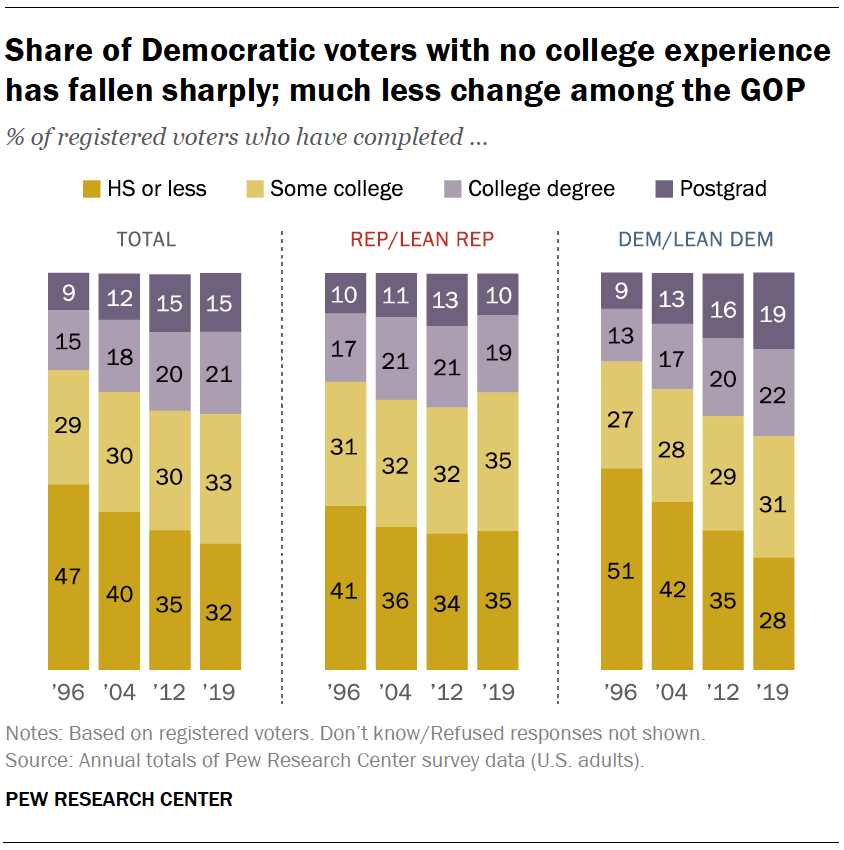
Around two-thirds of registered voters in the U.S. (65%) do not have a college degree, while 36% do. But the share of voters with a college degree has risen substantially since 1996, when 24% had one.
Voters who identify with the Democratic Party or lean toward it are much more likely than their Republican counterparts to have a college degree (41% vs. 30%). In 1996, the reverse was true: 27% of GOP voters had a college degree, compared with 22% of Democratic voters.
Religion
Christians account for the majority of registered voters in the U.S. (64%). But this figure is down from 79% as recently as 2008. The share of voters who identify as religiously unaffiliated has nearly doubled during that span, from 15% to 28%.
The share of White Christians in the electorate, in particular, has decreased in recent years. White evangelical Protestants account for 18% of registered voters today, down from 21% in 2008. During the same period, the share of voters who are White non-evangelical Protestants fell from 19% to 13%, while the share of White Catholics fell from 17% to 12%.
Around eight-in-ten Republican registered voters (79%) are Christians, compared with about half (52%) of Democratic voters. In turn, Democratic voters are much more likely than GOP voters to identify as religiously unaffiliated (38% vs. 15%).
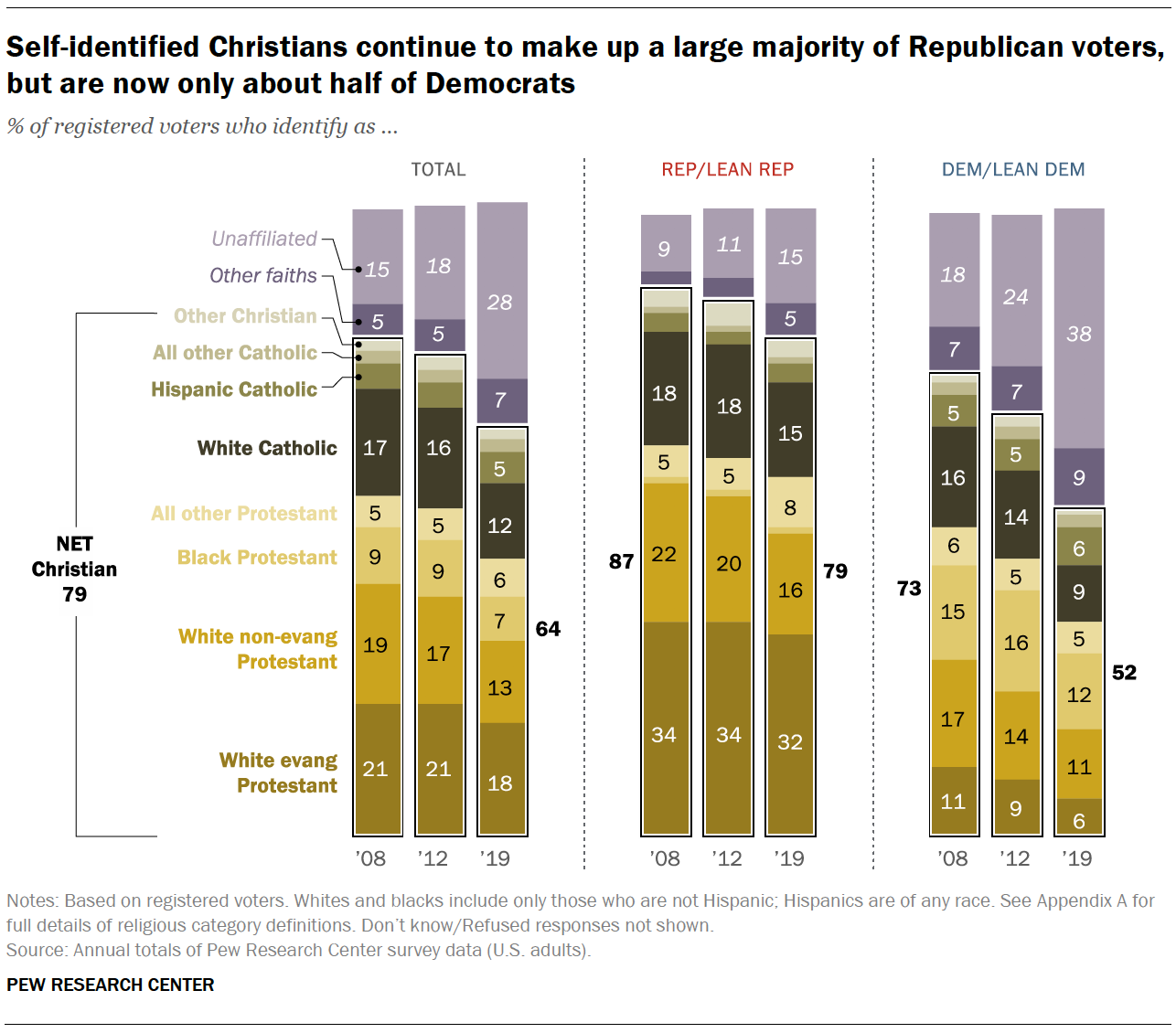
The key question: What about voter turnout?
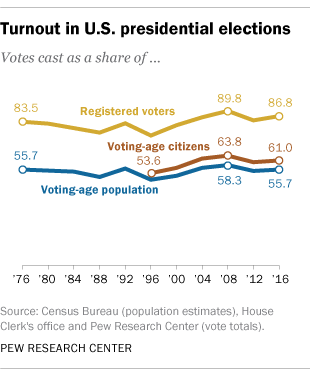
Surveys can provide reliable estimates about registered voters in the U.S. and how their partisan, demographic and religious profile has changed over time. But the critical question of voter turnout – who will be motivated to cast a ballot and who will not – is more difficult to answer.
For one thing, not all registered voters end up voting. In 2016, around 87% of registered voters cast a ballot, according to a Pew Research Center analysis of Census Bureau data shortly after that year’s election.
Also, voter turnout in the U.S. is not a constant: It can and does change from one election to the next. The share of registered voters who cast a ballot was higher in 2008 than four years ago, for example.
Turnout also varies by demographic factors, including race and ethnicity, age and gender. The turnout rate among Black Americans, for instance, exceeded the rate among White Americans for the first time in the 2012 presidential election, but that pattern did not hold four years later.
So what does all this mean for 2020? There are some early indications that overall turnout could reach a record high this year, just as turnout in the midterms two years ago reached its highest point in a century. But 2020 is far from an ordinary year. The combination of a global pandemic and public concerns about the integrity of the election have created widespread uncertainty, and that uncertainty makes it even more difficult than usual to assess who will vote and who won’t.
